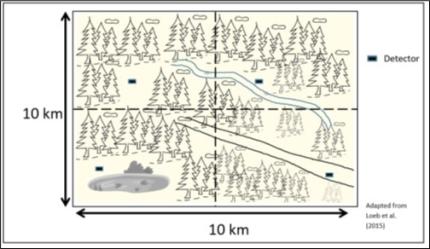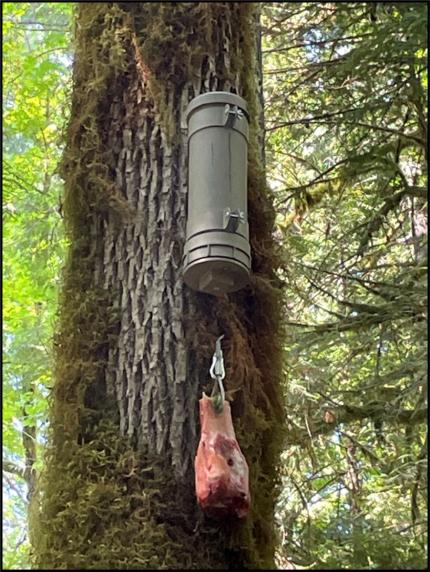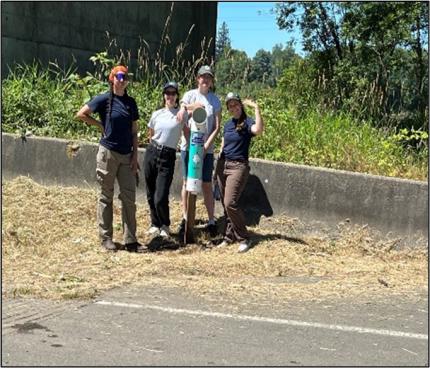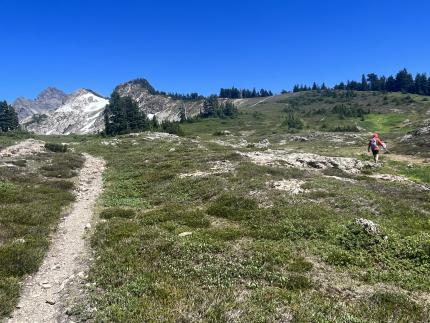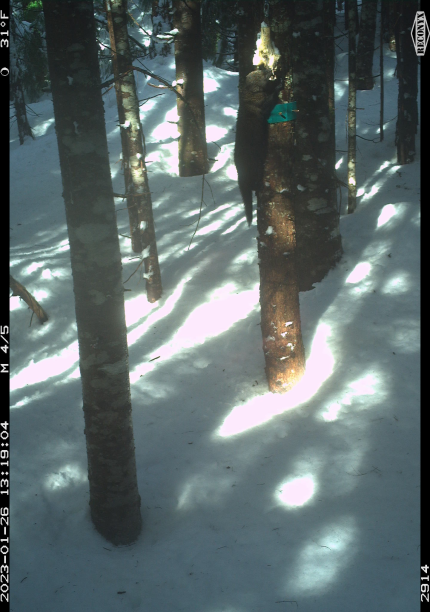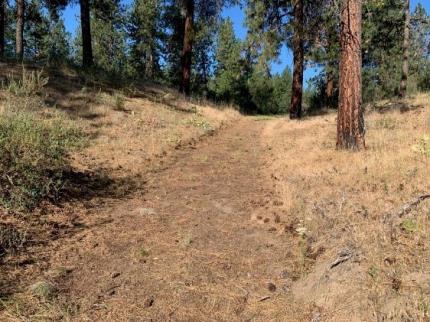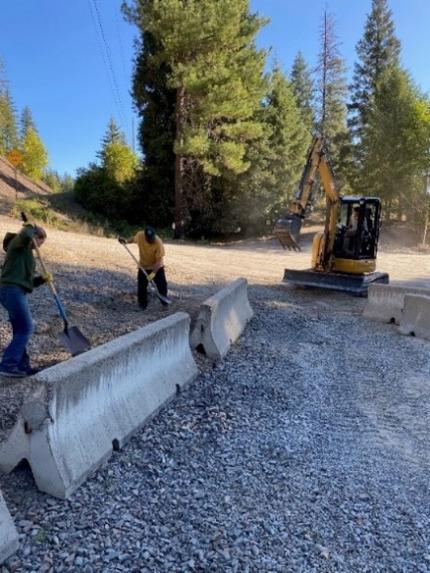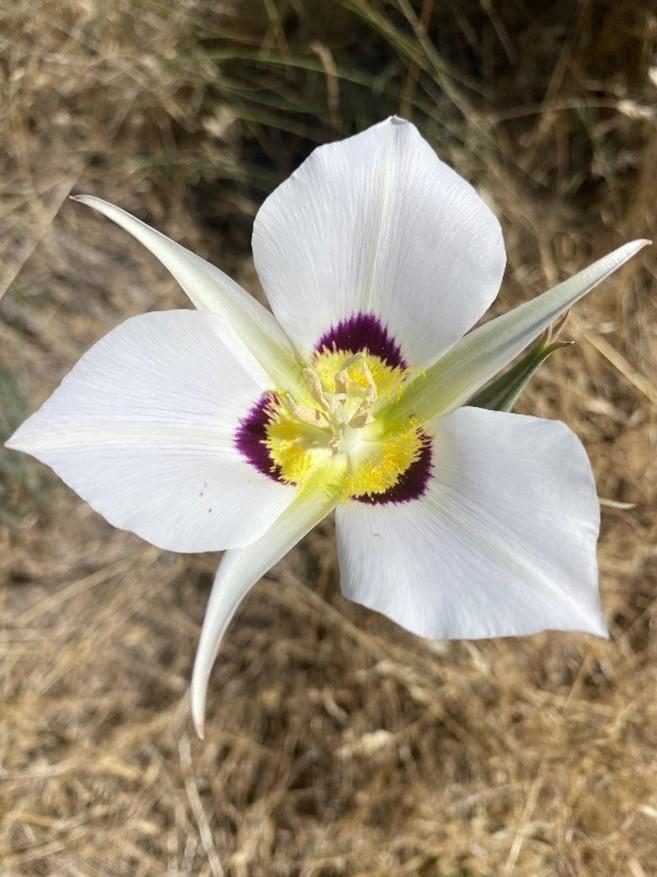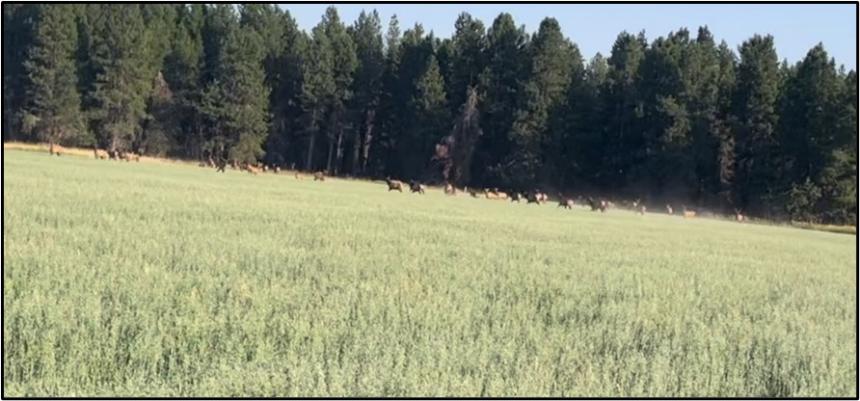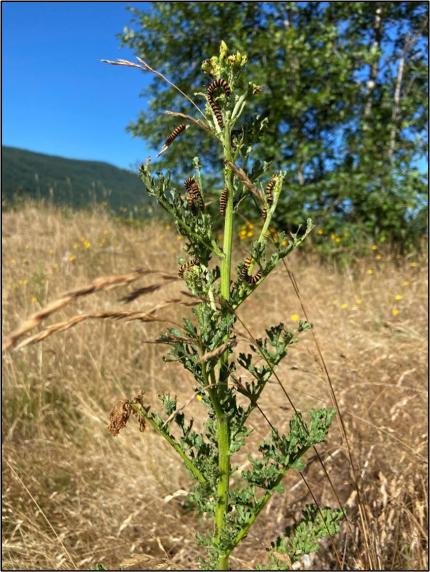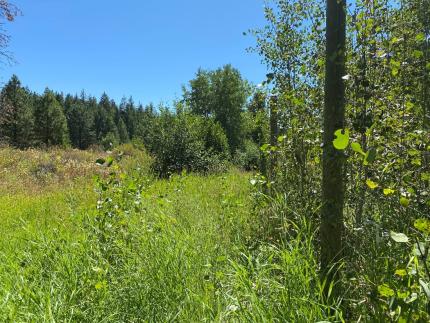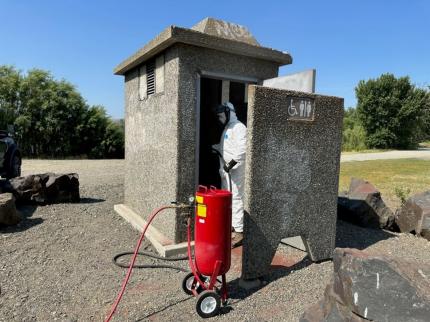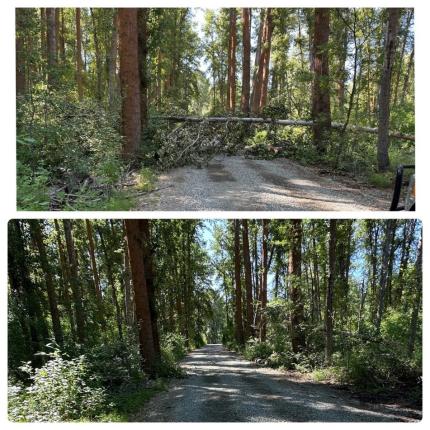Biweekly report Jul16-31 2024 - Region 2 (North Central)
Managing Wildlife Populations
Fisher Reintroduction Monitoring: Biologists Fitkin and Heinlen, with help from volunteer members, finished retrieving the remote cameras at sites that were deployed last fall. The cameras were part of the North Cascades occupancy monitoring effort following recent fisher reintroduction efforts. Overall, fishers were detected at 3 of the 21 sites. As always, the cameras are documenting a variety of other species of interest. Apparently, fisher scent lure is the trendy new fragrance for chic carnivores in the know.
Biologists Eilers, Jeffreys, and Turnock, along with Technicians Hara and Force, finished picking up baited camera stations. The stations were deployed in forested areas throughout Chelan County last fall as part of the North Cascades Fisher Monitoring project. Images collected at these baited camera traps will be used to help evaluate the effectiveness of the reintroduction of fishers back into the Cascades Fisher Recovery Area. The images will also inform future recovery actions by assessing the expansion and distribution of fishers. The idea was to draw any fishers inhabiting the vicinity into view of the game camera by placing a dispenser loaded with an extremely potent skunk scent over a bone on a tree approximately 15’-18’ away and in full view of the camera. The scent lure dispenser dripped this pungent liquid onto a bone every 48 hours throughout the deployment window, attracting any nearby carnivores. In addition to fisher, the baited camera stations were expected to capture images of other carnivore species of concern, including gray wolf, wolverine, and lynx. To further assess fisher occupancy and expansion, a hair snare belt was nailed to the tree right below the beef bone. The aim is to snag hairs from visiting animals climbing the tree that can then be used for DNA analysis. All data generated from these baited camera stations will be instrumental in learning more about the distribution of fishers and other carnivore species throughout the Cascades.
Fisher Monitoring: Technicians Force and Hara retrieved a camera trap and scent dispenser station aimed at attracting fishers. Fishers were reintroduced to the cascades in 2015-2020 after being absent since the mid 1900’s. No fishers were detected at this camera station, however a nearby station collected by the team caught a rare wolverine investigating the stinky skunk lure.
Lynx Surveys: Biologists Fitkin and Heinlen, with help from Forest Service Technician Barnett and volunteer member Fisher, deployed and array of remote cameras as part of long-term lynx monitoring strategy. This is part of the initial field season of the Cascades Carnivore Monitoring Project, a coalition of government agencies and non-profit groups seeking to monitor lynx and wolverine occupancy in the Washington Cascades over a 20-year period. The cameras will be retrieved later this summer and fall after a minimum 60-day deployment.
Bat Colony Surveying: Biologist Fitkin along with Headquarters and Regional Diversity staff members, Forest Service staff members, and local volunteer members completed the last of three scheduled bat colony reconnaissance surveys in the Methow Watershed. Results include the monitoring of a colony of more than 300 pallid bats, and the documentation of big brown bat colonies of more than 100 bats and colonies of more than 200 bats. This effort provides valuable information on species distribution and trends in Washington and helps identify possible locations for white-nosed syndrome monitoring and other bat conservation activities.
Lewis’s Woodpeckers: Biologists Eilers and Jeffreys, along with other WDFW and Chelan Public Utilities Department biologists, continue to conduct Lewis’s woodpecker (LEWO) surveys at five project areas in Rocky Reach Wildlife Area (RRWA). So far this year surveyors have completed occupancy surveys at all grids and have identified 20 occupied LEWO cavity nests. All cavity nests received multiple monitoring visits throughout the nesting cycle and many of the nests have fully fledged. Using a camera mounted to a telescoping pole (nest peeper), biologists have observed eggs or young nestlings in many of the nest cavities. Not all nest cavities can be reached with the nest peeper, as some are too high and/or have too many branches in the way. In those cases, biologists use behavioral observations to approximate nesting stage. In August, once all nests have been documented to have either fledged young or have failed, biologists will perform habitat assessment surveys at each nest cavity.
The goal of this year’s cavity nest surveys is two parts. The first is to learn more about LEWO nesting phenology and ecology of the population within the RRWA. This includes clutch size, number of eggs hatched, and number of hatchlings to reach fledging or late nestling phase. Second is to examine this data, alongside habitat and microhabitat characteristics, for the purpose of drawing inferences regarding nest success of LEWO at both the local scale and microsite scale (breeding territory). These inferences may in turn be useful for informing habitat management considerations at the regional scale (north central Washington).
Bat Acoustic Monitoring: Biologist Jeffreys and Eilers completed two North American Bat Monitoring (NABat) surveys, one in Chelan County and one in Douglas County. This was done as part of a joint effort between WDFW, Northwestern Bat Hub at Oregon State University, and other regional partners. These surveys consist of deploying four SM4 acoustic detectors throughout a pre-determined plot. SM4 acoustic detectors record the high frequency vocalizations of bats, allowing for call analysis and species identification. This data will be incorporated into the North American Bat Monitoring Program, which seeks to monitor local and regional bat populations across the continent and inform effective bat conservation.
Bat Emergence Counts: Biologists conducted the second and final rounds of emergence counts at three maternity colonies located in the south Lake Chelan, Entiat River Road, and Lake Wenatchee areas. Maternity colonies are communal roosts where females birth and care for their pups. The species of bats at these four colonies are little brown myotis (Myotis lucifugus), Yuma myotis (Myotis yumanensis), and big brown bats (Eptesicus fuscus). The Lake Wenatchee area roost is a new one for 2024. The Entiat and south Lake Chelan roosts have been monitored for several summers now and counts at both were down this year.
Bat Vaccine Project: Biologist Eilers joined WDFW’s bat specialist Abby Tobin, Ellensburg Wildlife Biologists Erin Wampole and Callie Moore, United States Geological Survey (USGS) researchers, and USFWS staff to assist with a bat vaccination project. The aim of this study led by USGS is to determine if immunization of bats against white nose syndrome (WNS) can improve bat survival and protect bat populations from disease related declines. This barn contains a maternity roost occupied annually by two species of bat: Little brown bat (Myotis lucifugus) and Yuma myotis (Myotis yumanensis). Bats were captured using a harp net and processed to collect data on species, age, and reproductive status. Additionally, bats were given an oral vaccine previously demonstrated to enhance survival upon WNS infection, and outfitted with a PIT tag to allow individual identification over the several years that monitoring will be conducted at this colony. Radio frequency identification (RFID) antennas will be placed at roost entrances to detect individual PIT tags as bats come and go.
Bumble Bees: Biologists Jeffreys and Eilers conducted the second and third bumble bee survey of the year at a site south of Wenatchee. This year’s survey efforts will include four repeated visits to the same site every few weeks to monitor changes in bumble bees and flowering plants throughout the summer season. Habitat data were collected for the grid, including identifying and photographing flowering plant (food source) species. A total of 13 bumble bees of six different species were caught on the second visit, and 12 bumble bees of four species were caught on the third visit. Bees were gently caught in a net, identified to species, and released on site. The data collected from this survey were entered into the Pacific Northwest (PNW) Bumble Bee Atlas online database. The PNW Bumble Bee Atlas is a collaborative effort between the Xerces Society for Invertebrate Conservation, WDFW, Idaho Department of Fish and Game, Oregon Department of Fish and Wildlife, and citizen science volunteer members to track and conserve the bumble bees of Washington, Idaho, and Oregon.
More on Bumble bee Surveys: Biologist Turnock and Technician Force surveyed for Morrison’s and western bumble bees at the Quincy Lakes Wildlife Area. These species are declining and understudied. These surveys are aimed at better understanding their range. Neither species of bumble bees were observed, however the diversity team got some great bee netting practice in.
Sharp-Tailed Grouse Monitoring: Technician Force investigated the last recorded location of a male grouse that had been fitted with a GPS collar during the translocations from Canada earlier this year. The collar had stopped recording location points and biologists wanted to confirm if there was a mortality. No sign of the bird or a mortality was observed.
Bullfrog Removal: Biologists Gallie and Turnock, along with Technicians Force and Hara, continue to assist with the bullfrog removal at the Columbia National Wildlife Refuge. There has been a significant decrease in the number of invasive and predatory bullfrogs inside the fenced off pond. It is hoped that this effort will enhance survival of the northern leopard frogs that will be released.
Providing Conflict Prevention and Education
Hunter Access: Biologist Cook and Technician Blanchard checked hunter access boundary signs to ensure the signs and contact information for hunters are intact and legible. These signs are the manner for which hunters obtain permission for the properties in Hunt by Written Permission, which is the most prevalent in Region 2.
Providing Conflict Prevention and Education
Depredation Investigation: Wildlife Conflict Specialist Heilhecker, along with enforcement officers, investigated an injured calf within the Sullivan Creek pack territory. They confirmed the injury was caused by a wolf. USFWS was notified of the determination. A WDFW contracted range rider continues to work in the area.
Responding to Inquiry from Landowner: Wildlife Conflict Specialist Heilhecker received a call about nutria damaging duck habitat on the reporting party’s (RP) property. The RP was confident the animals are nutria and not muskrats. The RP expressed concern the nutria were causing ducklings to die. The nutria arrived two years ago and since then, the mallard and pintail ducklings have all died. Heilhecker and the RP discussed other possibilities as to why the ducklings died.
Responding to Elk Complaints: Wildlife Conflict Specialist Heilhecker received three elk complaints in GMU 204. Elk are damaging livestock fences and eating crops before they can be harvested. She renewed damage prevention cooperative agreements for the landowners and issued kill permits.
Conserving Natural Landscapes
Habitat Plots: Biologist Morris continues checking hunter access signs in preparation for the fall hunting season.
Biologist Cook visited a habitat plot near Moses Lake, where additional shrub row planting is planned for this fall. The site has had an increase in invasive cheatgrass cover, so this planting may be delayed to improve weed control. The shrubs and warm season grasses require supplemental irrigation. Additional native cool season grass species may be seeding in the surrounding area to help compete with weeds especially when supplemental irrigation is not available.
Biologist Morris met with a landowner who has concerns about a gravel mining development permit application. Morris discussed potential impacts the development could have and what WDFW’s role is in reviewing permits. He referred the landowner to habitat Biologist Pentico, who deals with habitat mitigation in development permits.
Conducting Business Operations and Policy
Private Land Team Meeting: The private land team met to discuss safety issues, work through uploading and syncing phones with Garmin Inreach devices, and other relevant issues.
ATV/UTV Training: Biologist Morris, Biologist Cook and Technician Blanchard took ATV and UTV training and are now certified to operate them for WDFW. Morris was trained on ATVs at a past job and has been driving ATVs for over 20 years but was required to take the ATV training to comply with WDFW safety policies.
Wilderness First Aid: Biologist Morris and Biologist Cook took a two-day wilderness first aid course. This course was very helpful for knowing what to do in an emergency situation where emergency services could take hours or longer to arrive.
Other
F-150 Lightning: Biologist Morris will testing out the F1-50 Lightning, the WDFW fleet's all-electric pickup truck, for two weeks. Morris’ experience driving the Lightning will help WDFW determine how electric vehicles fit the business needs of the agency and private lands biologists.
Training: Wildlife Conflict Specialist Heilhecker completed several mandatory trainings.
Range Rider Payment: Wildlife Conflict Specialist Heilhecker completed paperwork to pay a WDFW contracted range rider for work monitoring livestock.


















